Starfleet Equipment
Created by Captain Zseeq on Sat Dec 16th, 2023 @ 3:58pm
Starfleet Equipment
Standard Equipment
Communicator
 The Communicator is a small, multi-purpose communications and universal translation device that is worn by members of Starfleet. Taking the form of the Starfleet insignia, the Communicator is a crystalline composite of gold, microfilament, silicon, beryllium, and carbon-70. Under current Starfleet Uniform Code, a Starfleet Officer who is not wearing a Communicator is considered to be out of uniform.
The Communicator is a small, multi-purpose communications and universal translation device that is worn by members of Starfleet. Taking the form of the Starfleet insignia, the Communicator is a crystalline composite of gold, microfilament, silicon, beryllium, and carbon-70. Under current Starfleet Uniform Code, a Starfleet Officer who is not wearing a Communicator is considered to be out of uniform.Communicators are designed for communication with others when the internal communication system is unavailable, for accessing the shipboard computer system, ship-to-shore communications, and for direct communication to another Communicator. Communicators are activated by pressing the device once and calling out the name or general area of the intended recipient, then are deactivated by another single press. The Communicator can also be programmed to accept voiceprint commands, including opening a channel to another and closing when the word "out" is uttered. Programmed with an internal universal translator circuit, the device is preprogrammed with 300 different languages within its database and has a working range of the Communicator is 40,000 kilometers, but can be boosted in some situations.
Communicators are a means of providing personal identification with the user's name and serial number engraved on the back of the badge. The device maintains identification credentials that could be used to login to Starfleet computers and equipment, utilizing biometric data saved within the device. A Communicator is also used by the Transporter as a way to lock on to Starfleet personnel.
Desktop Monitor
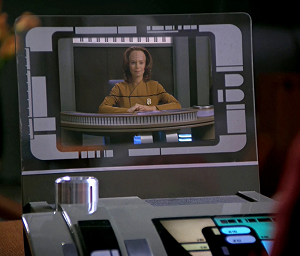 A Desktop Monitor is a personal computer console used as Starfleet personnel for personal library computer retrieval and for visual communications.
A Desktop Monitor is a personal computer console used as Starfleet personnel for personal library computer retrieval and for visual communications.Molded of duranium composite, the Desktop Monitor feature a holographic glass display and a base housing a Sarium Krellide power cell allowing the device to operate for up to 60 hours of continuous usage. Memory storage is provided by two banks of Isolinear circuits, allowing the device to store up to 1.21 megaquads of information while data processing occurs at 300 giga floating point (GFP) operations per second. An internal subspace transceiver assembly maintains communication with the main computer of the vessel, allows for connection to the Starfleet databank at Memory Alpha, and allows the device to accept communications.
Device inputs are commonly provided through the touch-sensitive, multilayered flat screen technology built into the monitor of the device; however, the Desktop Monitor can also accept voice commands. In some situations a Desktop Monitor can be configured to control any system aboard the vessel, but this authorization is limited to members of the vessel's command crew.
Personal Access Display Device (PADD)
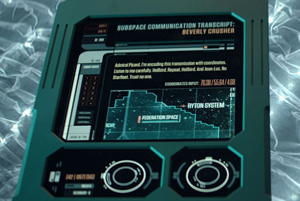 The Personal Access Display Device (or PADD for short) is a handheld computer interface in widespread use throughout the galaxy. Starfleet PADDs are powered by Sarium Krellide power cell are constructed of boronite, which enables the PADD to sustain a thirty-five-meter drop without significant damage. Internally, the PADD operates through the usage of two isolinear chips which can hold .
The Personal Access Display Device (or PADD for short) is a handheld computer interface in widespread use throughout the galaxy. Starfleet PADDs are powered by Sarium Krellide power cell are constructed of boronite, which enables the PADD to sustain a thirty-five-meter drop without significant damage. Internally, the PADD operates through the usage of two isolinear chips which can hold .Varying in size, shape and specification, PADDs are often distinguished by the species of their manufacturer or user with Federation PADDs generally being flat and rectangular in shape. The unit consists of a large touchscreen display with a minimalistic manual interface or control panel, generally comprising only one or two buttons. When needed, a PADD can display information on a built in holographic emitter with the information or object shared hovering above the device. The typical PADD is used for a variety of functions, including logging crew manifests, compiling duty rosters or diagnostic reports, entering personal data, and/or accessing library computer systems using the LCARS Interface. Starfleet personnel can conduct business through their PADD, including transferring the responsibilities of a workstation to the device if needed. Personal communications can be transmitted and received by a PADD, in audio, text, or video depending upon availability.
Phaser Type II
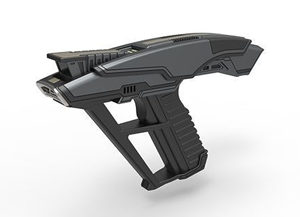 A Phaser Type II, or Phaser pistol, is a handheld directed-energy sidearm used by Starfleet and United Federation of Planets personnel and is standard issue for away teams and Officers aboard the ship. Powered by Sarium Krellide power cells, these Phasers have a duration of 250 discharges before needing to recharge.
A Phaser Type II, or Phaser pistol, is a handheld directed-energy sidearm used by Starfleet and United Federation of Planets personnel and is standard issue for away teams and Officers aboard the ship. Powered by Sarium Krellide power cells, these Phasers have a duration of 250 discharges before needing to recharge. Primarily a defensive weapon, the Phaser Type II is a particle weapon that produces high energetic, short-lived beams of energy through the rapid nadion effect. Featuring sixteen power settings ranging from light stun, which can cause unconsciousness in a humanoid for five minutes, up to heavy disruption, which can vaporize up to 600 cubic meters of rock, the Phaser can be set to multiple beam types depending on user's need. Outside of defensive purposes, the Phaser Type II has multiple applications as a tool including serving as a cutting tool, heating rock, and clearing obstructions.
In the mid-2380s, Starfleet redesigned the Phaser Type II from a sleek, silver-colored device with a handle flowing back to the rugged, gun-like appearance common in the 23rd Century. The default firing style of the Type II Phaser is a pulse but can be transitioned to a beam if necessary. Phasers are equipped with internal biometric sensors that limit the ability of a nonauthorized user from firing the weapon and also incorporate an internal subspace transceiver that limits the weapon to a maximum setting of heavy stun without the permission of the Commanding Officer.
Tricorder
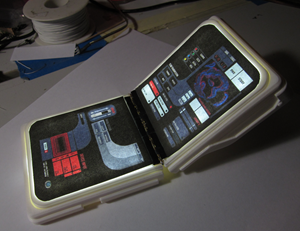 A Tricorder is an advanced multi-function hand-held computing and scanning device used to gather, analyze, and record data, with many specialized abilities. While capable in its default version, specialized Tricorder designs are employed by Starfleet to handle specific tasks.
A Tricorder is an advanced multi-function hand-held computing and scanning device used to gather, analyze, and record data, with many specialized abilities. While capable in its default version, specialized Tricorder designs are employed by Starfleet to handle specific tasks.Featuring a streamlined, unibody construction, the Tricorder incorporates a broad array of sophisticated sensors and miniaturized computer technology to assist in analysis of an environment, person, or object. When fully charged the Tricorder can be continually active for up to 36 hours, but can operate for almost 1,000 hours of noncontinuous use. With a range of 2,000 meters for a long-range scan, routine analysis of a item can occur almost instantaneously, but high-resolution scans can take up to an hour to complete. Internal communications technology, similar to that of the Starfleet Communicator, allow the Tricorder to interface with the computer systems of the Saratoga and allow a Tricorder to hack into alien computer equipment.
While a Tricorder is capable of operation in a variety of environments, a Tricorder is not infallible. Electromagnetic interference and jamming signals can be used to limit the effectiveness of a Tricorder to reduce their effective range and certain equipment and materials can be used to block Tricorder scanning signals, rendering the device useless.
Uniform
 Starfleet Uniforms are worn by individuals serving in the Federation Starfleet. Designed for comfort and durability in the most extreme environments, Starfleet uniforms facilitate the wearers' needs as both scientists and researchers, as well as Starfleet's military role. Wearers are expected to abide by the Starfleet Uniform Code, though special exceptions can be made to honor aspects of an individual's cultural heritage.
Starfleet Uniforms are worn by individuals serving in the Federation Starfleet. Designed for comfort and durability in the most extreme environments, Starfleet uniforms facilitate the wearers' needs as both scientists and researchers, as well as Starfleet's military role. Wearers are expected to abide by the Starfleet Uniform Code, though special exceptions can be made to honor aspects of an individual's cultural heritage.While the color scheme had varied over time, Starfleet uniforms are classified by color with the current colors in practice:
- Command: The Command Division is responsible for the administration of starships, starbases, and space stations. These personnel are distinguished by red coloration.
- Operations: The Operations Division is the backbone of Starfleet and incorporates the engineering, operations, and security departments. This group is responsible for technological innovation and for maintaining and defending the Federation and typically wear uniforms with gold coloration.
- Science: The Sciences Division is the heart of Starfleet and comprises members of the exploratory, medical, and mental health departments within the fleet. Science personnel are identified by uniforms with teal coloration.
- Service: The Service Division fulfills all support roles within Starfleet and are identified by uniforms with silver coloration.
Engineering Equipment
Medical Equipment
Scientific Equipment
Security Equipment
Phaser Type I
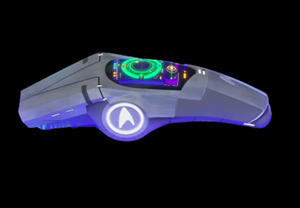 Carried by Starfleet personnel when it would be inappropriate to use a larger weapon (such as serving on a diplomatic mission or during "undercover" work for Starfleet Intelligence), a Phaser Type I is the smallest, most basic weapon carried by Starfleet personnel and is capable of 100 shots before recharge. The Type I Phaser is a common sight on worlds of the Federation and is the primary weapon of most civilian police forces with the galaxy.
Carried by Starfleet personnel when it would be inappropriate to use a larger weapon (such as serving on a diplomatic mission or during "undercover" work for Starfleet Intelligence), a Phaser Type I is the smallest, most basic weapon carried by Starfleet personnel and is capable of 100 shots before recharge. The Type I Phaser is a common sight on worlds of the Federation and is the primary weapon of most civilian police forces with the galaxy.Maintaining a streamlined grip reminiscent of late 24th century Type II Phaser, the Type I Phaser design has been in use since the 2380s and has been designed with concealment in mind, easily fitting in the pocket or sleeve of the user. Firing primarily in beam format, the Type I Phaser does not have the power of its larger Type II cousin and is limited to only eight adjustable discharge settings due to the weapon only having a single prefire amplification chamber. Despite this, the Type I Phaser is a lethal weapon in the hands of a skilled fighter and is a capable defensive weapon.
Phaser Type III
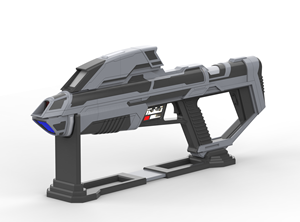 The Type III Phaser, also known as the Phaser Rifle, is a larger, more powerful weapon deployed in highly dangerous situations. While slightly less powerful than the contemporary weapons used by other governments, Starfleet Phaser Rifles are designed with larger power packs and a third prefire amplification chamber, allowing the weapon to operate for longer periods of time and to discharge more shots before needing to be recharged. By default the Phaser Rifle fires a Phaser pulse, but can be reconfigured to beam settings depending on mission profile and feature the same power settings as the Phaser Type II.
The Type III Phaser, also known as the Phaser Rifle, is a larger, more powerful weapon deployed in highly dangerous situations. While slightly less powerful than the contemporary weapons used by other governments, Starfleet Phaser Rifles are designed with larger power packs and a third prefire amplification chamber, allowing the weapon to operate for longer periods of time and to discharge more shots before needing to be recharged. By default the Phaser Rifle fires a Phaser pulse, but can be reconfigured to beam settings depending on mission profile and feature the same power settings as the Phaser Type II. Phaser Rifles are fitted with technologies designed to improve the weapon's accuracy. The Type III Phaser is supplemented by fully-autonomous recharge capability, multiple-target acquisition, and gyro-stabilization devices to make them more accurate in hazardous situations. A tracking light could be mounted on the central body, as well as a shoulder strap attached to the upper surface to allow ease of carrying. Additional peripherals can be attached to the weapon to increase its combat utility including a specialized tracking scope that allows for firing on a target at distance. An underslung grenade launcher - comprising a barrel, breech and four-round internal magazine - can be fitted for heavy combat situations where there is an extreme risk to the user.
Categories: No categories found